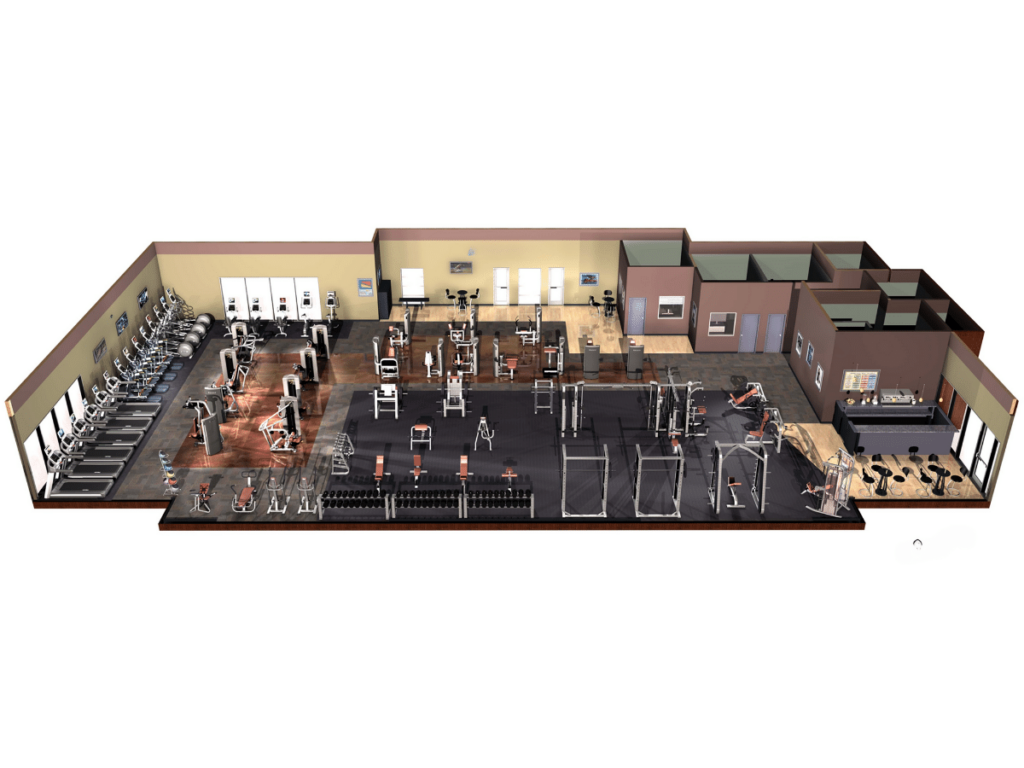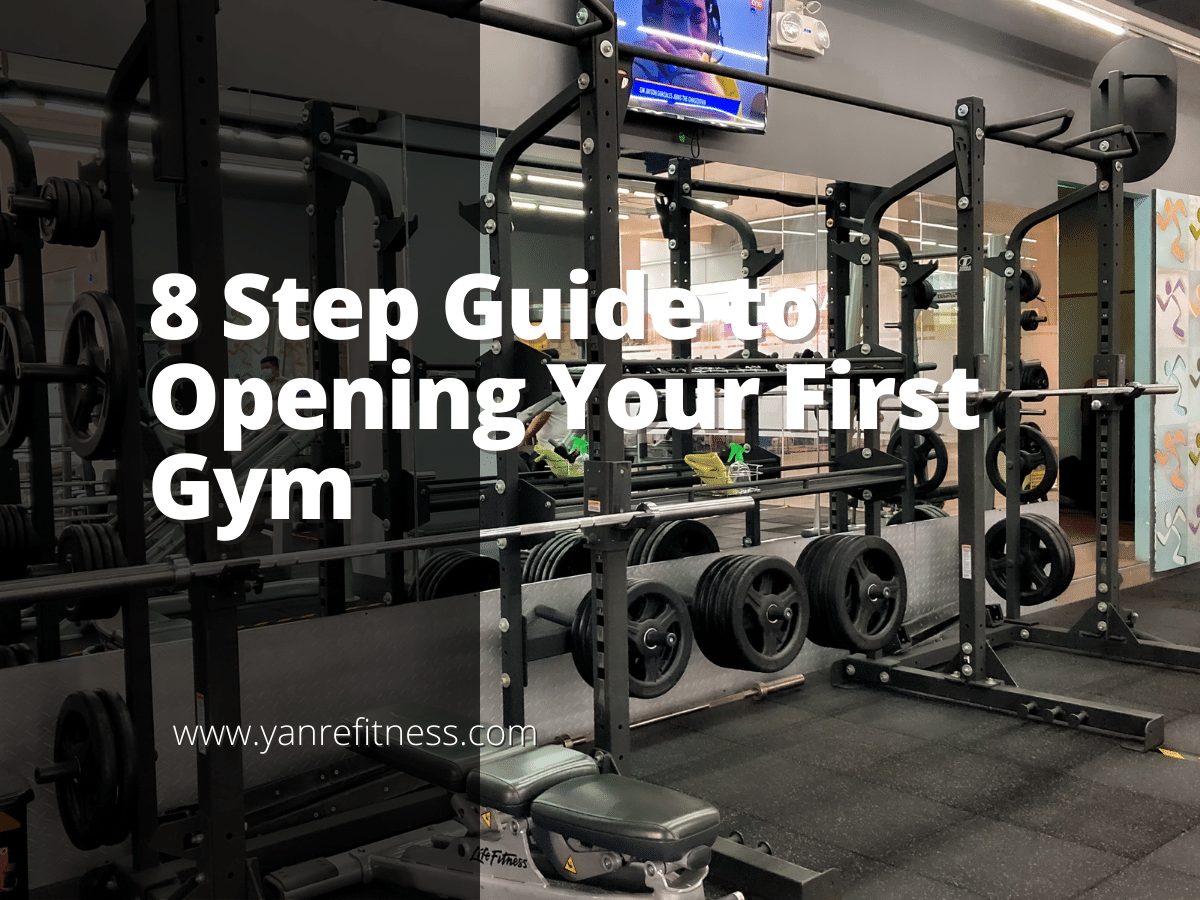If you’re a personal trainer looking to take your fitness career to the next level and make a lasting impact, opening your own gym could be the game-changer you need. However, the process can be overwhelming and challenging.
But don’t worry, we’ve got you covered with our ultimate guide for personal trainers. This guide is designed to streamline the process and set you up for success, so you can say goodbye to confusion and hello to a thriving business.
So, read on to unlock the secrets of opening your first gym and take your fitness career to new heights.
Table of Contents
1. Planning Phase
The journey to open a fitness center starts with a clear plan. The planning phase sets the foundation, involving the definition of vision and mission, understanding the target audience, market research, setting achievable goals, and securing financing options. This stage significantly contributes to the long-term success of the gym. Here are the steps in during the planning:

Defining Vision and Mission
Creating a clear vision and mission is crucial for the direction of any business. A vision outlines the long-term view of what the business intends to become. It inspires and provides a sense of purpose. Similarly, a mission clarifies the fundamental purpose of the business, outlining why the business exists, and what it aims to do.
Identifying Target Audience
Understanding the target audience is vital for customizing gym services to meet their specific needs. For example, a gym could target working professionals who value fitness but have limited time, offering efficient, high-intensity workout options. Some factors to look at are such as age, gender, fitness level, and economic status are crucial in identifying the demographic profile of potential customers.
Conducting Market Research
Market research provides insight into the competition, the fitness trends, and the potential challenges and opportunities within the fitness industry, especially when considering opening a gym in a small town. It assists in making informed decisions about the services offered, pricing, marketing strategies, among other elements. In my own journey, market research proved to be pivotal in positioning the business within a competitive landscape.
Creating a Business Plan
A comprehensive business plan guides the operational, financial, and marketing strategies of the gym, especially when you’re planning to open a CrossFit gym. It encompasses executive summary, company description, market analysis, organizational structure, services offered, marketing, and sales strategies. Crafting my business plan, gave me a clear structure on how to allocate resources, attract customers, and ultimately, grow the gym into a thriving fitness center.
Securing Financing Options
Establishing a gym requires a significant initial investment. Therefore, identifying and securing suitable financing options is crucial. These may include personal savings, bank loans, investors, or even crowd funding.

2. Location and Facilities
Choosing the right location and setting up the appropriate facilities are crucial steps in starting a gym. Finding an ideal location, assessing space requirements, choosing the right type of facility, and evaluating whether to lease or purchase are all significant decisions that must be carefully considered. Read on to learn more about these critical steps to ensure gym’s location presence:
Ideal Location
The location should be conveniently accessible to prospective clients, situated in a safe area, and have ample parking. Being in close proximity to complementary businesses, such as health food stores or wellness centers, could also be advantageous. For example, Pure Physique in New York successfully capitalized on its location in a high-traffic area, close to businesses and residences.
Space Requirements
A spacious area is needed for group fitness classes, whereas a more compact space can be sufficient for weightlifting or cardio machines. Balancing the need for different spaces within the gym will ensure a functional and pleasant environment for clients. Remember, it’s just like arranging furniture in a home, wanting everything to fit comfortably and invitingly.
Lease or Purchase Options
Consider the long-term financial implications before deciding to lease or buy. Leasing could be a more affordable option in the short-term, providing flexibility and less maintenance. On the other hand, purchasing a property can be a significant long-term investment, granting full control over the space.
Gym Layout and Design
A well-planned gym layout optimizes space usage, enhances clients’ experience, and promotes safety. Placing equipment in logical, grouped categories, with clear pathways, improves navigation and prevents accidents. In the early days of my journey, the understanding of the importance of layout and design was a game-changer.

Necessary Equipment and Supplies
High-quality, durable gym equipment is an investment that can significantly influence client satisfaction. Yanre Fitness ensures that every investment is worthwhile, providing robust and reliable equipment that will meet the rigorous demands of daily use. Buying or leasing decisions should be based on the budget, space available, and the target audience’s workout preferences.
3. Legal and Regulatory Considerations
Navigating the legal and regulatory landscape is an inevitable and critical phase in the establishment of a new gym. A precise understanding of this process ensures smooth operations, mitigates potential liabilities, and conforms with government regulations. Let’s learn more about its critical steps:

Gym as a Legal Entity
Registering gym as a legal entity not only provides a corporate structure but also safeguards personal assets from potential future liabilities related to the gym business. It is also a prerequisite for applying for licenses, permits, and even opening a bank account for the business. Sort of like building a fortress around your business and your personal life – separation is the key.
Licenses and Permits
Acquiring the necessary licenses and permits is another fundamental step in opening a gym. This process may vary depending on the geographical location and the scale of the business. However, in most jurisdictions, the common licenses and permits required are business licenses, building permits, health permits, and music licenses.
Health and Safety Regulations
A critical aspect of running a gym business involves adhering to health and safety regulations. It involves ensuring clean and hygienic premises, safe and well-maintained equipment, trained first-aid staff, and clear safety protocols. It is crucial to familiarize oneself with the local health and safety laws to ensure compliance.
Employment Laws and Contracts
This involves having a thorough understanding of the laws governing employment, wages, working hours, equal opportunity, and safety. Moreover, all staff members should have contracts that clearly define their roles, responsibilities, rights, and obligations. I personally stress on this because I believe in establishing a clear, legal understanding with my staff members.
Inssured Gym and Trainers
This protects the business from financial losses resulting from potential accidents or damages. It is advisable to obtain a comprehensive insurance policy that covers property, liability, and workers’ compensation. In 2020, over 44% of the fitness industry’s workforce lost their jobs, emphasizing the importance of insurance coverage to safeguard against unforeseen circumstances, according to Global Health and Fitness Association.
4. Branding and Marketing
In the ever-evolving world of fitness and entrepreneurship, the idea of opening a gym is both exciting and challenging. One key aspect that is paramount to the success of a new gym is strategic Branding and Marketing. This sector includes several critical components:

Strong Brand Identity
Crafting a robust brand identity is crucial to establish a gym’s presence in the competitive fitness market. A strong brand identity can create a loyal following, and potentially transform the gym into a lifestyle choice. In the early days, focus was placed on building a unique and recognizable brand identity. This ethos has carried through, shaping the gym into a revered institution in the fitness industry.
Professional Website
A professional website not only communicates the philosophy and services of the gym, but also facilitates management tasks such as bookings, product sales, and communication with gym members. Think of it as your virtual receptionist, working 24/7 to keep things smooth and efficient.
Social Media Platforms
Harnessing the power of social media can help the gym reach a wider audience. Platforms such as Instagram, Facebook, and Twitter can be used to share fitness tips, motivational content, and highlight member achievements. The utilization of fitness apps can augment a gym’s social media presence, providing avenues for one-on-one interaction with members.
Effective Marketing Strategies
Applying effective marketing strategies, such as SEO, content marketing, and collaborations can help attract new members to the gym. While running a gym, adopting such innovative marketing strategies has often yielded impressive results. It’s like a lighthouse, drawing people in with its light, illuminating the benefits of your gym.
Local Influencers and Partners
In the age of social media, collaborating with local influencers and partners can amplify the reach of the gym. Influencers can promote the gym to their followers, potentially attracting new members. Similarly, partnerships with local businesses can provide members with exclusive benefits, creating a value-added proposition that enhances member retention.
5. Hiring and Training Staff
A gym is defined not only by its facilities and equipment but, importantly, by the quality of its trainers and employees. Let’s explore the key considerations for hiring qualified personnel, and training your team.

Staffing Needs
The number and expertise of employees needed will largely depend on the size of the gym and the variety of services provided. A thorough analysis of the gym’s operational requirements can help identify the specific roles and responsibilities that need to be filled, from gym managers to personal trainers and maintenance staff.
Qualified Trainers and Employees
A strong team of professional trainers and employees contributes significantly to the success of a gym. Thus, the recruitment process should focus on attracting candidates with the necessary qualifications, skills, and experience. In my own experience, hiring staff who are not only knowledgeable but also passionate about fitness has always made a significant difference in creating a positive gym environment.
Interviews and Background Checks
Interviews provide a glimpse into a candidate’s character, work ethic, and compatibility with the gym’s culture. Meanwhile, background checks ensure the safety and reliability of the potential hire. This process also involves verifying their qualifications and certificates, particularly for trainers who will be working directly with gym members.
Onboarding Process
This process usually involves an introduction to the gym’s facilities, systems, and safety protocols. It also provides an opportunity to align new staff members with the gym’s culture, values, and goals.
Training and Professional Development
Training and professional development should be provided such programs can help employees enhance their skills, stay updated with the latest fitness trends, and continuously improve the service they provide to gym members. In fact, promoting a culture of learning and growth within the staff has been one of my key strategies in running a successful gym.
6. Gym Operations
Running a successful gym isn’t just about having state-of-the-art equipment and a beautiful venue, it requires effective operations management. This is a broad field encompassing a range of critical tasks, let’s know more about these steps:
Membership Plans and Pricing
Developing clear and competitive membership plans and pricing strategies are essential steps in gym operations. With a well-thought-out pricing strategy, businesses can balance profit margins with member satisfaction, thereby enhancing gym sustainability. I have been challenged to find the sweet spot that provides value to members and also covers operating costs.

Booking and Scheduling Systems
Efficient booking and scheduling systems can greatly improve the member experience by allowing them to easily book classes or personal training sessions. These systems need to be intuitive and easy-to-use and flexible, catering to various class types and training sessions. Gym management software plays a significant role here.
Gym Policies and Rules
Having clear and enforceable gym policies and rules is critical to ensuring a safe and comfortable environment for all members. These policies may include rules for equipment use, acceptable behavior, gym etiquette, and safety standards. Imagine it as a set of house rules – keeping everyone on the same page and preventing misunderstandings. These rules should be communicated effectively and consistently to all members.
Cleanliness and Maintenance
Maintaining cleanliness and ensuring regular maintenance of gym equipment is non-negotiable. A clean gym is not only a healthy gym, but also one that people will want to return to. From my experience, investing in regular maintenance and cleanliness checks have resulted in fewer equipment breakdowns and an overall happier gym community.

Finances and Accounting
Sound financial management is key to any gym’s survival and growth, including when starting a non-profit gym. This includes everything from managing revenue and expenses to ensuring the proper handling of gym membership payments. Many gyms use gym management software that offers financial management features, providing automated, accurate, and up-to-date financial information.
7. Building a Community
Building a community involves developing a space that resonates with and supports the health and wellness journeys of gym members. To do so, various tactics are employed such as creating a welcoming atmosphere, organizing group fitness classes and events, offering specialized training programs, encouraging member engagement and feedback, and providing exceptional customer service.
Welcoming and Inclusive Atmosphere
Creating an atmosphere that feels welcoming and inclusive is a pivotal aspect of building a gym community. Gym Desk stated that fostering a friendly and encouraging environment is essential for delivering an excellent client experience. It involves making sure that each member feels safe, comfortable, and valued irrespective of their fitness level, age, or background.

Group Fitness Classes and Events
Such classes allow members to interact, share their experiences, and support each other towards achieving their fitness goals. Organized events, on the other hand, offer opportunities for members to connect outside of the fitness context, which strengthens the bonds within the community. Creating a women’s only gym provides a unique and safe space for women to come together and pursue their fitness journeys. The gym can offer specialized fitness classes tailored to women’s needs and preferences, fostering a sense of empowerment and camaraderie among members.
Specialized Training Programs
Offering specialized training programs can range from beginner-level training for those just starting their fitness journey, to advanced-level training for those seeking to push their limits. As per my personal experience, specialized programs can be incredibly impactful in creating a sense of accomplishment among members, thus leading to a stronger community.
Member Engagement and Feedback
Engaging with members and taking their feedback seriously is a key element in building a thriving gym community. By encouraging open dialogue, it becomes easier to understand their needs and preferences better. With Yanre Fitness’s commitment to superior quality and user experience, deliver fitness equipment that exceeds member expectation, thereby enhancing member satisfaction and loyalty.
Exceptional Customer Service
Exceptional customer service is crucial in any business, and it’s no different for a gym. Ensuring that each member feels heard, valued, and well-taken care of significantly contributes to building a strong community. I have been witnessing, gyms that prioritized customer service were more successful in their operations.
8. Retention and Growth Strategies
Retaining members and growing a gym’s base is a multifaceted task that requires strategic planning. This section explores the various components of member retention and gym growth, from developing tailored programs to monitoring key performance indicators, embracing industry trends, and diversifying revenue streams.
Member Retention Programs
Developing an effective member retention program can significantly boost a gym’s revenue and stabilize its future prospects. One strategy is to personalize the gym experience, leveraging member data such as attendance, goals, milestones, and equipment usage to create customized programs. In own business journey, when members developed connections with fellow gym-goers, they were more likely to stick around.
Referral and Loyalty Programs
Another potent strategy for increasing member retention and attracting new members is implementing referral and loyalty programs. Such programs can incentivize existing members to introduce their friends to the gym, transforming them into advocates. Simultaneously, loyalty programs reward long-standing members, encouraging them to maintain their membership.
Tracking Key Performance Indicators
Using technology to track key performance indicators (KPIs) can be transformative in managing a gym’s success. Data on member attendance, satisfaction levels, and workout diagnostics, to name a few, can be invaluable resources in identifying areas of improvement and potential growth.
Industry Trends and Adapting
Staying attuned to industry trends can provide opportunities for innovation and adaptability. A gym should be ready to evolve with the changing fitness landscape, ensuring it remains relevant and attractive to members.
Services and Diversifying Revenue Streams
Expanding services and diversifying revenue streams can significantly contribute to a gym’s growth and resilience. Offering varied workout classes, personal training sessions, and health and wellness seminars can increase the value for members. Similarly, selling fitness merchandise and nutritional supplements or renting space for events can provide additional income.
Conclusion
Opening your first gym as a personal trainer is an exciting and rewarding journey, made smoother with the right guidance. By following the ultimate guide, you’ll set yourself up for success in the fitness industry. Now is the time to take action and make your gym ownership dreams a reality.
Yanre Fitness is here to support you every step of the way. Contact us for more product details, our catalog, a price list, or any assistance you may need. Together, we’ll bring your vision to life and create a thriving fitness space that benefits both you and your clients.
Related articles:








